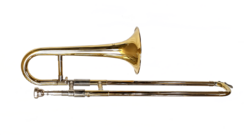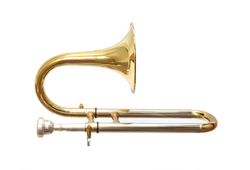Engineering:Soprano trombone
 Soprano trombone in B♭ | |
| Brass instrument | |
|---|---|
| Other names |
|
| Classification |
|
| Hornbostel–Sachs classification | 423.22 (Sliding aerophone sounded by lip vibration) |
| Developed | Late 17th century |
| Playing range | |
<score lang="lilypond">
{
\new Staff \with { \remove "Time_signature_engraver" }
\clef treble \key c \major \cadenzaOn
e1 \glissando c1
}
</score> | |
| Related instruments | |
| Musicians | |
| |
| Builders | |
| |
The soprano trombone (sometimes called a slide trumpet or slide cornet, especially in jazz) is the soprano instrument in the trombone family of brass instruments, pitched in B♭ an octave above the tenor trombone. As the bore, bell and mouthpiece are similar to the B♭ trumpet, it tends to be played by trumpet players rather than trombonists. Compared to tenor, bass, or even uncommon alto, the soprano is a rare trombone. Seldom used in classical music since its first known appearance in 1677, it survived principally in the trombone ensembles of Moravian Church music. During the 20th century some soprano trombones—dubbed slide cornets—were made as novelties or for use by jazz trumpet players including Louis Armstrong and Dizzy Gillespie. A small number of contemporary proponents of the instrument include jazz artists Wycliffe Gordon and Christian Scott, and classical trumpeter Torbjörn Hultmark, who advocates for its use as an instrument for young children to learn the trombone.
History
Whether the soprano trombone was ever widely used in history is still a matter for debate.[3] The earliest surviving instrument was made in 1677, held by the Kremsegg musical instrument museum.[4] German Baroque composer Johann Sebastian Bach composed three cantatas (BWV 2, 21 & 38) around 1723 with four trombone parts; the highest was written in soprano clef, for a diskant-posaune (lit. descant trombone).[5]
The soprano trombone was used in German-speaking countries to play the treble part in chorales, and this tradition survives in the trombone choirs of Moravian Church music.[5] Outside of this, there is little evidence of the instrument being employed in musical ensembles or written works since the 18th century. This may have been because the Stadtpfeiffer (lit. town pipers), who were trained to play all instruments, found fast and high (soprano) passages easier to play on the cornett.[6]
Soprano trombone is seldom mentioned in the major orchestration treatises of the 19th century. German musicologist Adolf Bernhard Marx (1847) and English music scholar Ebenezer Prout (1897) only mention the soprano to state that it is considered obsolete, and French organist and composer Charles-Marie Widor in his 1904 treatise only mentioned that some manufacturers were still making them, while describing the alto as obsolete.[7]
During the 20th century some soprano trombones—dubbed slide cornets or later, slide trumpets—were made as novelties or for use by jazz players. These were used by a few jazz trumpet players like Louis Armstrong and Dizzy Gillespie, but otherwise have not been widely adopted.[5][8]
Construction
The B♭ soprano trombone is built with dimensions similar to the B♭ trumpet. The bore size is between 0.450 and 0.470 inches (11.4 and 11.9 mm), and the bell is 5 to 6 inches (130 to 150 mm) in diameter. It usually takes a trumpet mouthpiece, although some instruments are made with a smaller shank to take a cornet mouthpiece.[2] The slide of a soprano trombone is much shorter than that of a standard tenor trombone, with the slide positions only half the distance apart.
Soprano trombones are made by several trombone manufacturers, often as inexpensive novelty instruments, although high quality professional instruments are made by Kanstul, Miraphone, Thein and others.[2]
In the early 2010s, trumpeter Torbjörn Hultmark of the Royal College of Music commissioned the first soprano trombone with an F attachment, built by German maker Thein Brass.[9] Helmut Voigt, another German manufacturer, also makes a soprano with an F valve.[2]
Sizes
Trombones smaller than the soprano have only been built since the 1950s, when they first appeared as novelty or "show" instruments.[10]
The sopranino trombone in E♭, a fourth higher than the soprano and an octave above the alto, exists only in small numbers custom made for Moravian churches in the United States.[11]
The piccolo trombone in B♭ is an octave above the soprano. It is essentially a piccolo trumpet with a slide instead of valves, and is used with a piccolo trumpet mouthpiece.[11] Bore sizes are 0.460 inches (11.7 mm) or smaller, with bells approximately 4 inches (10 cm) in diameter. The piccolo is offered by Thein, Chinese manufacturer Jinbao, and Wessex.[12] Thein also make a novelty piccolino trombone in F, a fourth higher than the B♭ piccolo, originally made for the German Brass ensemble.[13]
Performance, range and pedagogy
The soprano trombone's similarity to the trumpet—its high pitch, mouthpiece size and narrow embouchure—means it is usually played by trumpeters. The player must combine both trumpet playing and trombone slide techniques to control intonation and note selection accuracy.
{
\new Staff \with { \remove "Time_signature_engraver" }
\clef treble \key c \major \cadenzaOn
e1 \glissando c1
}
</score>Soprano trombone parts are usually written in treble clef and, like the trumpet, can be in concert pitch or transposed in B♭. The range of the B♭ soprano trombone is similar to the B♭ trumpet, E3 to C6.[1]
As part of his "Soprano Trombone Project", Torbjörn Hultmark has used the instrument to successfully begin children on brass instruments from as young as the age of four, and is the world's first registered Suzuki teacher in soprano trombone.[14] Hultmark has also worked with the British Music Teachers Board to produce a syllabus of grade examinations for the soprano trombone.[15] Other researchers have reported the soprano trombone can also be used as a pedagogical tool to help trumpet players improve several core aspects of their playing technique.[16]
Repertoire
There is very little classical repertoire written specifically for soprano trombone. The earliest pieces are three cantatas by Johann Sebastian Bach and two passions by Georg Philipp Telemann (as edited by his grandson) from the early 18th century, and a large body of Moravian Church music for trombone choir from the late 18th and 19th century.[3]
In contemporary music, composers have very occasionally included soprano trombone in orchestral works. British composer Brian Ferneyhough called for two in his large 2006 work Plötzlichkeit; after playing one of the parts in a performance, Hultmark became a proponent of the soprano trombone as a serious instrument.[9] He has written and commissioned new compositions for it, and promotes its use as a first instrument for children.[5]
In jazz, some contemporary artists are employing the soprano trombone in their work.[17] Wycliffe Gordon and Christian Scott both use the instrument in solos and on their albums.[18][19] New York musician Steven Bernstein has become well known for playing the "slide trumpet" in his band, Sexmob.[20][21]
References
- ↑ 1.0 1.1 1.2 Herbert, Myers & Wallace 2019, p. 481, Appendix 2: The Ranges of Labrosones.
- ↑ 2.0 2.1 2.2 2.3
- "Soprano trombones". Helmut Voigt. https://helmut-voigt.com/diskantposaune/.
- "JBST-1800拉管小号降B调" (in zh). Jinbao. http://www.jinbaomusic.com/index.php?s=index/show/index&id=664.
- "Model 150 B♭ Soprano Trombone". Kanstul Musical Instruments. https://www.kanstul.com/instruments/trombones/150-bb-soprano-trombone/. Ceased operations in 2020.
- "Bb soprano slide trombone". Miraphone eG. https://www.miraphone.de/bb-soprano-slide-trombone-2.html.
- "Soprano Trombone" (in en). Thein Brass. https://thein-brass.de/en/instrument/soprano-trombone/.
- "Soprano Trombone – PB453". Wessex Tubas. https://www.wessex-tubas.com/products/soprano-trombone-pb453.
- ↑ 3.0 3.1 Weiner, Howard (2001). "The Soprano Trombone Hoax". Historic Brass Society Journal 13: 138–160. https://www.historicbrass.org/edocman/hbj-2001/HBSJ_2001_JL01_008_Weiner.pdf. Retrieved 27 April 2022.
- ↑ Laubhold, Lars E. (2000). "Sensation or forgery? The 1677 soprano trombone of Cristiann Kofahl". Historic Brass Society Journal (Historic Brass Society) 12: 259–65. https://www.historicbrass.org/edocman/hbj-2000/HBSJ_2000_JL01_013_Lauphold_Weiner.pdf. Retrieved 2 May 2022.
- ↑ 5.0 5.1 5.2 5.3 Yeo 2021, p. 137–8, "soprano trombone".
- ↑ Herbert 2006, p. 28.
- ↑ Guion 2010, p. 52.
- ↑ Petard, Gilles (c. 1923). King Oliver And His Creole Jazz Band (Photograph). Armstrong, Louis (slide trumpet). Getty Images. Retrieved 23 May 2023.
- ↑ 9.0 9.1 Salmon, Jane (23 June 2016). "The Soprano Trombone Project". Jane Salmon (blog). https://janesalmon.info/2016/06/23/the-soprano-trombone-project/.
- ↑ Guion 2010, p. 3.
- ↑ 11.0 11.1 Yeo 2021, p. 106, Piccolo trombone.
- ↑
- "Piccolo Trombone". Thein Brass. https://thein-brass.de/en/instrument/piccolo-trombone/.
- "JBSL-8150小号Bb/A" (in zh). Jinbao. http://www.jinbaomusic.com/index.php?s=index/show/index&id=883.
- "Piccolo Trombone – PB300". Wessex Tubas. https://www.wessex-tubas.com/collections/trombones-and-sackbut/products/piccolo-trombone-pb300.
- ↑ "Piccolino Trombone". Thein Brass. https://thein-brass.de/en/instrument/piccolino-trombone/.
- ↑ Hultmark, Torbjörn (October 2020). "What is the best age to start playing a brass instrument?". ITG Journal (International Trumpet Guild): 46.
- ↑ "Soprano Trombone Syllabus". MTB Exams. Music Teachers' Board. 2020. https://www.mtbexams.com/syllabus/soprano-trombone/.
- ↑ Spencer, Ryan (2021). "Soprano Trombone: Pedagogical Applications of the Slide for Trumpeters". The International Trumpet Guild. https://trumpetguild.org/content/videos/84-Research/2209-Spencer-2021.
- ↑ Sanborn, Chase (16 April 2013). "The Slide Trumpet". Halftime Magazine. https://halftimemag.com/sectionals/the-slide-trumpet.html.
- ↑ Gordon, Wycliffe (soprano trombone); Saunders, Jay (Music Director) (16 January 2017) [Recorded 4 March 2015]. Wycliffe Gordon plays SWING THAT MUSIC at CancerBlows 2015 (Excerpt from DVD). Morton H. Meyerson Symphony Center, Dallas, Texas: CancerBlows. Solo beings at 2 min, 57 sec. Archived from the original on 25 May 2022. Retrieved 26 May 2022 – via YouTube.
- ↑ Harold, C. N. (29 October 2007). "Album Review: Christian Scott: Anthem". All About Jazz. https://www.allaboutjazz.com/anthem-christian-scott-concord-music-group-review-by-cn-harold.
- ↑ Bernstein, Steven. "Biography". Steven Bernstein. https://www.stevenbernstein.net/about. "Bernstein formed Sexmob with saxophonist Briggan Krauss, bassist Tony Scherr and drummer Kenny Wollesen. It remains his primary vehicle for exploring the slide trumpet"
- ↑ Jarenwattananon, Patrick (9 May 2013). "Sexmob: Live From 92Y Tribeca". NPR Music. NPR. https://www.npr.org/2013/05/09/182462927/sexmob-live-from-92y-tribeca.
Bibliography
- Guion, David M. (2010), Wikidata Q111039945
- Herbert, Trevor (2006), Wikidata Q111039091
- Herbert, Trevor; Myers, Arnold; Wallace, John, eds. (2019), Wikidata Q114571908
- Yeo, Douglas (2021), Wikidata Q111040546
External links
- Torbjörn Hultmark: Soprano Trombone Project
- Moravian Music Foundation: The Moravian Trombone Choir
 |




